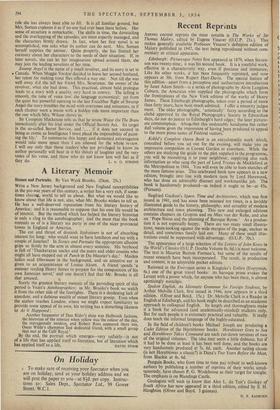Recent Reprints
AMONG current reprints the most notable is The Works of Sir Thomas Malory, edited by Eugene Vinaver (O.U.P. 21s.). This makes generally available Professor Vinaver's definitive edition of Malory published in 1947, the text being reproduced without com- mentary or critical apparatus.
Edinburgh: Picturesque Notes first appeared in 1879, when Steven- son was twenty-nine; it was his second book. It is a youthful work, effective in a characteristic way, even if precious and immature. Like his other works, it has been frequently reprinted, and now appears at 30s. from Rupert Hart-Davis. The special feature of this edition—apart from a perceptive and authoritative introduction by Janet Adam Smith—is a series of photographs by Alvin Langdon Coburn, the American who supplied the photographs which form the frontispieces of the New York edition of the works of Henry James. These Edinburgh photographs, taken over a period of more than forty years, have been much admired. I offer a minority judges ment. The older photographs, 'artistically' fuzzy according to the cliché approved by the Royal Photographic Society in Edwardian days, do not do justice to Edinburgh's hard edges; the later picture- are commonplace. Altogether this undeniably handsome but rather dull volume gives the impression of having been produced to appeal to the more pious tastes of Festival visitors.
Kobbe's Complete Opera Book is an encyclopaedic work which, consulted before you set out for the evening, will make you an impressive companion at Covent Garden or elsewhere. While the others are studying the guide to the plot supplied in the programme, you will be recounting it to your neighbour, supplying also such information as who sang the part of Lord Tristan de Mickleford at the Metropolitan in 1884. You will even be able to hum snatches of the more famous arias. This celebrated book now appears in a new edition, brought into line with modern taste by Lord Harewood, who has done an admirably discreet and workmanlike job. The book is handsomely produced—as indeed it ought to be—at 45s. (Putnam).
Siegfried Giedion's Space, Time and Architecture, which was first issued in 1941, and has since been reissued ten times, is a lavishly illustrated guide to the history, philosophy, and actuality of modern architecture and town planning. This new and enlarged editions contains chapters on Gropius and on Mies van der Rohe, and also on 'Pope Sixtus and the planning of Baroque Rome.' As a produc- tion it is not especially happy. There are too many small illustra- tions, mean-looking against the wide margins of the page, unclear in detail, and sometimes fussily laid out. Many of these small illus- trations could be suppressed with advantage. (O.U.P. 70s.).
The appearance of a large selection of the Letters of John Keats in the World's Classics (O.U.P. Double Volume 8s. 6d.) is most welcome. The text is Maurice Buxton Forman's, but some of the results of recent research have been incorporated. The result, in production and content, is an admirable pocket edition.
Reissued in the Everyman series is Kinglake's Eothen (Everyman. 6s.) one of the great travel books: its baroque prose evokes the Levant with a power which, for anyone who has been there, is almost agonisingly nostalgic.
Spoken English, An Idiomatic Grammar for Foreign Students, by Arthur Melville Clark, first issued in 1946, now appears in a third edition. (Oliver and Boyd. 15s.) Dr. Melville Clark is a Reader in English at Edinburgh, and his book might be described as an academic approach to colloquial English. Its length and thoroughness make it a book for advanced (and academically-minded) students only. But for such people it is extremely practical and valuable. It really does teach the informal language of the highly-educated.
In the field of children's books Michael Joseph are producing a Cadet Edition of the Hornblower books. Hornblower Goes to Sea and Hornblower Takes Command are each cut-down versions of two of the original volumes. The idea may seem a little dubious, but if it had to be done at least it has been well done, and the books are very handsomely produced at 7s. 6d. each. Another sailing classic (is not Hornblower a classic?) is Dana's Two Years Before the Mast, from Blackie at 4s. 6d.
Penguin Books, who from time to time pay tribute to well-known authors by publishing a number of reprints of their works simul- taneously, have chosen P. G. Wodehouse as their target for tonight. The emphasis is on Blandings Castle.
Geologists will wish to know that Alex L. du Toit's Geology of South Africa has now appeared in a third edition, edited by S. H. Haughton (Oliver and Boyd. 3 guineas).
N. P. RAEBURN


































 Previous page
Previous page